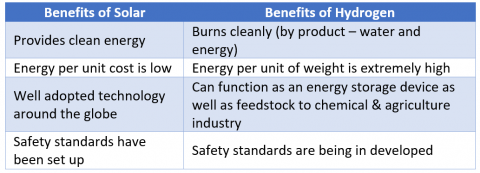Apart from having a significant potential to mitigate climate change, if implemented properly, these two can contribute to social and economic development, energy access, a secure energy supply, reducing negative impacts on the environment and health.
Since the 19th century, the global energy demand has been mainly fulfilled by energy produced by fossil fuels, leading to a rapid increase in CO2 emissions and global warming. In 2015, intending to tackle global warming, 196 Parties at COP 21 in Paris signed the Paris Agreement intending to limit global warming to well below 2°Celsius, preferably to 1.5°Celsius, compared to the pre-industrial levels.
There are several alternatives for lowering CO2 emissions from the energy system value chain while still fulfilling the global demand for energy services. Two of these potential alternatives are solar and hydrogen (green, yellow, and blue). Apart from having a significant potential to mitigate climate change, if implemented properly, these two can even contribute to social and economic development, energy access, a secure energy supply, reducing negative impacts on the environment and health.
Solar as an energy source is said to be the frontrunner to fight climate change. In the last decade, price of the solar modules has been fallen by 90 percent, which made solar energy the fastest-growing power source in the world. As per International Renewable Energy Agency (IRENA), the current global install capacity of solar energy is 586GW, up from 41GW in 2010. Institute of Energy Economics and Financial Analysis (IEEFA) statistics show that in the past decade, India has seen a significant drop of 86.7 percent in the solar tariff i.e., from ₹15 to ₹1.99. Solar energy can be also used for a wide range of applications like solar electric power generation, solar water heating, solar pumps, solar cooking, etc. However, there are some challenges associated with solar energy, first is its dependence on weather, and second, storage of solar energy for a longer duration is expensive.
Alongside solar, hydrogen has also started making traction in the energy domain and several countries have started exploring it as a potential candidate for fighting climate change. As per International Energy Agency (IEA), out of the current global demand of 74Mt hydrogen, most of it is derived from fossil fuels but more than 25 countries have started focusing on green and blue hydrogen with the help of developing an effective framework and national missions. India holds a significant share of 8-10 percent of total global hydrogen demand. As per IRENA, with speedy scale-up and aggressive electrolysers deployment in the next decade, by 2030, we can bring down the cost of green hydrogen by 60 percent. Further, it can start competing with blue hydrogen, and with continued growth, it can be made cheaper than other low-carbon alternatives before 2040. In India, the current pilot project of hydrogen-based fuel cells in the Leh region is producing electricity with a levelized cost of energy (LCOE) of ₹28 irrespective of getting solar energy at a cheaper rate. Hydrogen can be used in a vast range of sectors like power, transport, marine, aviation, cement, steel, fertilizer, and oil refining. A few of the challenges associated with hydrogen are lack of safety standards, higher cost for production and transportation, and lower efficiency of fuel cells among others.
One of the best ways to fight climate change and lower the dependency on fossil fuels is by integrating two or more green alternate technology so that one's drawbacks can be substituted by another.
Around the globe, solar energy is integrated with other technologies especially battery energy storage systems to mitigate its time-variant. For longer duration and life, battery energy storage system faces a major hurdle of cost and lifecycle, this hurdle can be overcome by using other technology like flow batteries, pump hydro, compressed air energy storage, and hydrogen-based fuel cell. Also, for producing green hydrogen, the energy needed should be from renewable energy, and due to a significant drop in solar tariff, solar energy can play a significant role in its production. Also, for India to achieve 450GW of renewable energy target by 2030 which is five times higher than its current installed capacity of renewable energy of 92GW, green hydrogen will play a vital role. Currently, around 15GW of solar PPA are left unsigned due to low demand during solar generating hours and problems like the duck curve challenge. This makes green hydrogen the best suitable choice to work together with solar for the use of cheap clean power. Solar and hydrogen together can reduce the $160 billion energy import of India and can help in achieving twin goals - energy security and de-carbonization, as only 18 percent of total energy consumption are in the form of electricity, and the rest 82 percent need other forms of deep-carbonization (refining, fertilizer, steel, chemical, and heavy-duty transport industry). Therefore, to achieve India's Paris Agreement goals and to bring an end to being 3rd largest emitter of CO2, solar and hydrogen will work together by providing not only clean energy but also by decarbonizing other carbon-intensive industries.
This article is authored by Shivam Chauhan, Analyst, Customized Energy Solutions.
Read More


